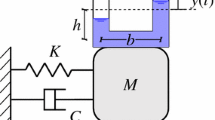Abstract
Tuned Liquid Column Damper (TLCD) relies on the motion of a liquid mass in an open tube counteract the external motion, while a built-in orifice plate induces turbulent damping forces that dissipate kinetic energy. Although both the construction and working principle of TLCD differ from Tuned Mass Damper (TMD), the analogies between TLCD-structure and TMD-structure system for symmetric and asymmetric structures are given. The mass ratio, the optimal frequency ratio, the natural frequency and damping of the main structure, etc are achieved. Modal tuning of the TLCD, frequency ratio and damping, is classically done by applying the Den Hartog optimization criterion. The analysis of structural vibration control using finite element software is presented. Numerical simulations of the four-storey asymmetric structure and 20-storey benchmark model with single TLCD or TLCDs with the parameters using Den Hartog formula and structural analysis by SAP 2000 software show that the method of transforming TLCD-structure to TMD-structure system is reasonable and feasible.
Similar content being viewed by others
References
Matteo, A. D., Lacono, F. L., Navarra, G., and Pirrotta, A. (2015). “Optimal tuning of tuned liquid column damper systems in random vibration by means of an approximate formulation.” Meccanica, Vol. 50, No. 3, pp. 795–808.
Balendra, T., Wang, C. M., and Cheong, H. F. (1995). “Effectiveness of tuned liquid column dampers for vibration control of towers.” Engineering Structures, Vol. 17, No. 9, pp. 668–675.
Chakraborty, S. and Debbarma, R. (2015).“Robust optimum design of tuned liquid column damper in seismic vibration control of structures under uncertain bounded system parameters.” Structure and Infrastructure Engineering, DOI: 10.1080/15732479(in press).
Den Hartog, J. P. (1956). Mechanical vibration, (4th Edition), McGraw-Hill, New York, NY, USA.
Fu, C. and Ziegler, F. (2009). “Vibration prone multi-purpose buildings and towers effectively damped by tuned liquid column gas dampers.” Asian J.Civil Engineering, Vol. 10, No. 1, pp. 21–56.
Fu, C. (2011). “Active TLCGD control of plane asymmetric buildings under earthquake excitation.” Acta Mechanica Sinica, Vol. 27, No. 5, pp. 817–822.
Hochrainer, M. J. and Ziegler, F. (2006). “Control of tall building vibrations by sealed tuned liquid column dampers.” Structural Control and Health Monitoring, Vol. 13, No. 6, pp. 980–1002.
Hitchcock, P. A., Kwok, K. C. S., Watkins, R. D., and Samali, B. (1997). “Characteristics of liquid column vibration absorbers (LCVA)-I.” Engineering Structures, Vol. 19, No. 2, pp. 126–134.
Huo, L. S. and Li, H. N. (2012). “Structural vibration control using semi-active variable stiffness tuned liquid column damper.” Journal of Vibration and Shock, Vol. 31, No. 10, pp. 157–164.
Lin, S. M. (2016). “Nonlinear vibration control of a tall structure with tuned liquid column damper”, Mechanics of Advanced Materials and Structures, Vol. 23, No. 2, pp. 146–155.
Liu, G., H., Li, H. N., and Guo, W. (2011). “An equivalent calculation method for analysis of structural vibration control of transforming TLD-structure to TMD-structure system.” Engineering Mechanics, Vol. 28, No. 5, pp. 31–34.
Loi, T. and Ikeda, T. (1977). “On the dynamic vibration damped absorber of the vibration system.” Bull JSME, Vol. 43, No. 369, pp. 1707–1715.
Ohtori, Y., Christenson, R. E., and Spencer, B. F. J. (2004). “Bechmark control problems for seismically excited nonlinear buildings.” Journal of Engineering Mechanics, Vol. 130, No. 4, pp. 366–385.
Peng, J. S., Luo, Y. K., and Peng, D. (2007). Structural dynamicas, aseismic design and SAP2000 applications, (1st Edition), Southwest Jiaotong university press, Cheng Du, Si Chuan, China.
Reiterer, M. and Ziegler, F. (2006). “Control of pedestrian-induced vibrations of long-span bridges.” Structural Control and Health Monitoring, Vol. 13, No. 13, pp. 1003–1027.
Xu, Z. D. (2010). Analysis and application of commonly used software in civil engineering (MATLAB-SAP2000-ANSYS), China building industry press, Beijing, China.
Bigdeli, Y. and Kim, D. (2016). “Damping effects of the passive control devices on structural vibration control: TMD, TLD and TLCD for varying total masses.” KSCE Journal of Civil Engineering, Vol. 20, No. 1, pp. 301–308.
Ziegler, F. (1998). Mechanics of Solids and Fluids, (2nd Edition), Springer, New York, NY, USA.
Author information
Authors and Affiliations
Corresponding author
Rights and permissions
About this article
Cite this article
Fu, C. Transforming Method of TLCD-structure to TMD-structure for Vibration Control. KSCE J Civ Eng 22, 1384–1393 (2018). https://doi.org/10.1007/s12205-017-0287-5
Received:
Accepted:
Published:
Issue Date:
DOI: https://doi.org/10.1007/s12205-017-0287-5




